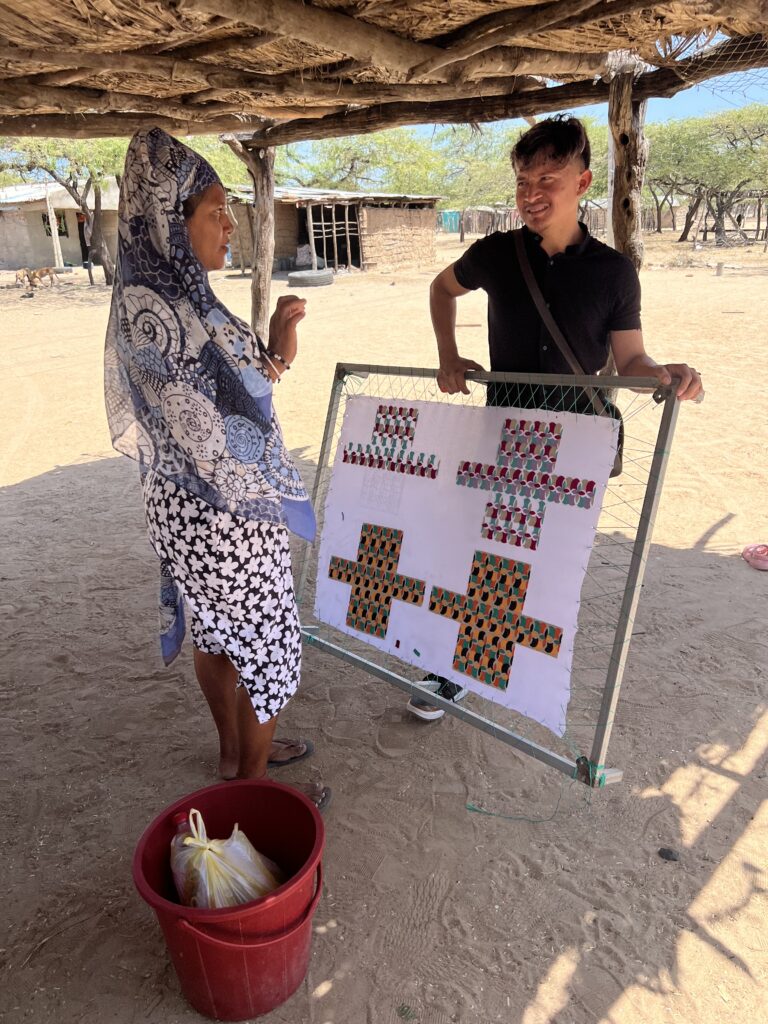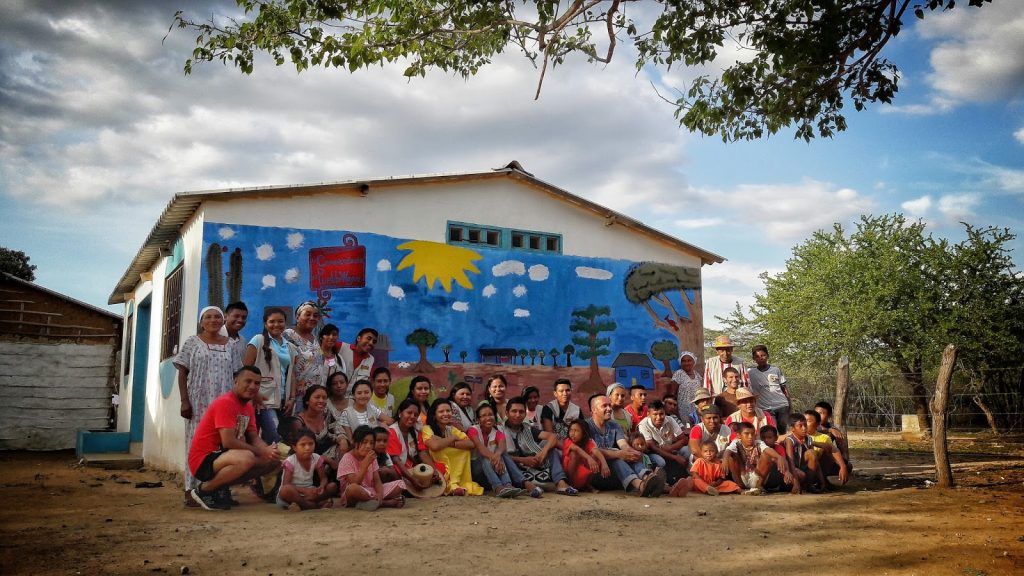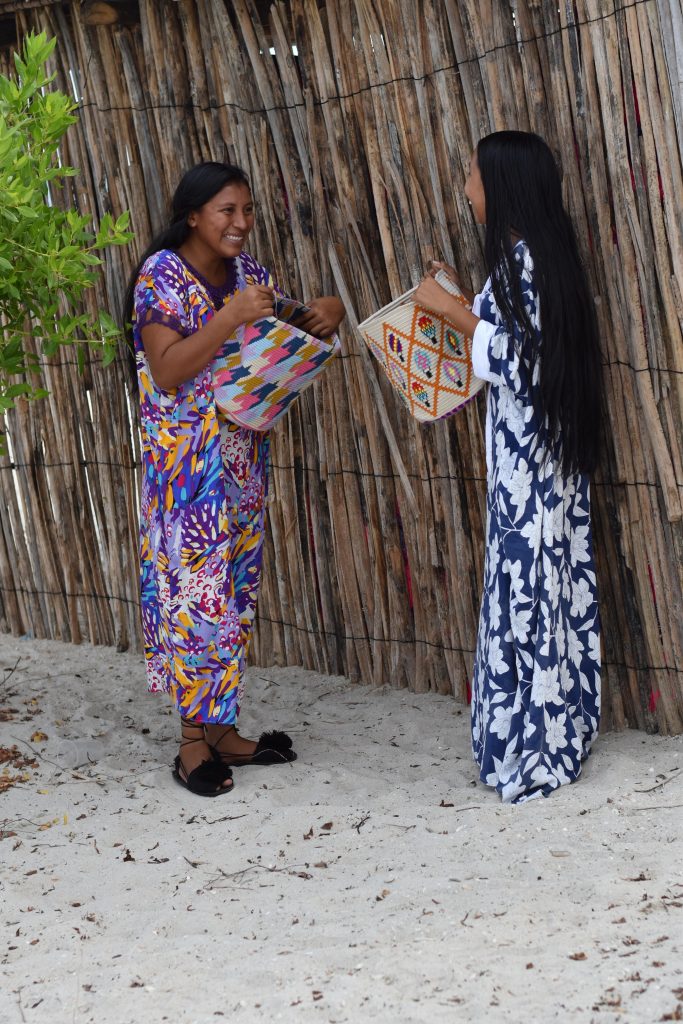
Bilingual education is helping preserve Wayuu culture in La Guajira, Colombia, where poverty and climate change threaten the survival of Wayuunaiki. In the arid landscapes of La Guajira, Colombia, the Wayuu people are striving to preserve their ancestral language, Wayuunaiki, amid poverty and climate change. Bilingual education initiatives, such as the innovative El Arroyo school, are blending traditional Wayuu knowledge with modern curricula—offering a vital path to cultural preservation and resilience.
The Wayuu people are confronted with numerous socioeconomic and environmental challenges that threaten the survival of their language, Wayuunaiki. One of the most pressing issues is poverty. Many Wayuu families live below the poverty line, with limited access to basic necessities such as food, clean water, and healthcare. This economic hardship makes it difficult for families to prioritize education and the preservation of their language.
Additionally, the Wayuu community faces severe malnutrition. Children and adults alike suffer from inadequate diets, which impacts their overall health and ability to concentrate in school. This, in turn, affects their capacity to learn and use Wayuunaiki in educational settings.
Environmental challenges also play a significant role. Climate change has led to prolonged droughts in the region, severely affecting the Wayuu’s traditional way of life, which relies heavily on agriculture and livestock. These environmental changes force the Wayuu people to migrate in search of better living conditions, disrupting the transmission of their language to future generations.
The Wayuunaiki language is more than just a means of communication; it is a cornerstone of the Wayuu people’s cultural identity. Language is intrinsically linked to the community’s traditions, rituals, and way of life. Preserving Wayuunaiki is essential for maintaining the cultural heritage and collective memory of the Wayuu people.
Traditions such as storytelling, songs, and ceremonies are all conducted in Wayuunaiki. These cultural practices are vital for passing down knowledge and values from one generation to the next. The loss of the language would mean the erosion of these traditions and a profound impact on the community’s sense of identity and belonging.
Furthermore, the Wayuunaiki language serves as a bond that unites the Wayuu people. In a world that is increasingly globalized, maintaining their language helps the Wayuu retain their unique cultural identity and resist assimilation into the dominant cultures of Colombia and Venezuela. It empowers them to take pride in their heritage and continue to celebrate their distinct way of life.
Bilingual education is a vital strategy for preserving the Wayuunaiki language while promoting integration into broader societal contexts. By offering instruction in both Wayuunaiki and Spanish, bilingual education programs ensure that students can maintain their cultural heritage while gaining the skills needed to thrive in a modern world.
One of the primary benefits of bilingual education is that it provides a structured environment where Wayuunaiki can be used and celebrated. This reinforces the language’s importance and encourages its daily use among young people. Additionally, these programs often incorporate traditional Wayuu knowledge and practices, further embedding cultural values within the educational experience.
Moreover, bilingual education helps bridge the gap between the Wayuu community and the larger Colombian and Venezuelan societies. By being proficient in both languages, Wayuu students can navigate different cultural contexts with ease, increasing their opportunities for higher education and employment.
The benefits of bilingual education extend beyond language preservation. For students, learning in both Wayuunaiki and Spanish enhances academic performance. Research shows that bilingual children often have better cognitive abilities, including improved problem-solving skills and greater mental flexibility.
For the community, bilingual education fosters a stronger sense of cultural pride. When children learn their ancestral language and traditions in school, it reaffirms the value of their heritage. This, in turn, strengthens community bonds and encourages the preservation of cultural practices. Additionally, bilingual education programs can lead to greater community involvement. Parents and elders are often invited to participate in educational activities, sharing their knowledge and experiences. This collaborative approach not only enriches the educational experience but also ensures that the community remains actively engaged in the preservation of their language and culture.
The Language Law of 2010 in Colombia represents a significant milestone for the preservation of indigenous languages, including Wayuunaiki. This legislation acknowledges the linguistic diversity of the country and establishes measures to protect and promote the use of native languages. By prioritizing the preservation of languages like Wayuunaiki, the law aims to safeguard the cultural heritage of indigenous communities.
One of the key provisions of the law is the requirement for educational institutions to incorporate indigenous languages into their curricula. This mandate ensures that children from indigenous communities, such as the Wayuu, receive education in their mother tongue alongside Spanish.
Furthermore, the law provides for the training and certification of bilingual teachers. This initiative aims to address the shortage of qualified educators who are proficient in both Spanish and indigenous languages.
UNESCO’s recognition of tribal judges plays a crucial role in strengthening cultural conservation efforts for the Wayuu community. These judges, known as “palabreros,” are traditional leaders who hold significant authority within the community. Their recognition by an international organization like UNESCO underscores the importance of their role in preserving Wayuu culture and language.
The endorsement of tribal judges by UNESCO validates the traditional justice system of the Wayuu people, which relies on oral traditions and the use of Wayuunaiki. This recognition helps ensure that these practices are respected and continue to be passed down through generations.
In La Guajira, several schools have emerged as pioneers in the implementation of bilingual education. One notable example is El Arroyo in Riohacha. These schools are dedicated to offering a balanced education that incorporates both traditional Wayuu knowledge and modern educational practices.
El Arroyo and similar institutions employ a curriculum that is bilingual by design. Classes are conducted in both Wayuunaiki and Spanish, ensuring that students become proficient in both languages. This bilingual approach not only preserves the Wayuunaiki language but also equips students with the linguistic skills necessary to succeed in broader Colombian society.

Despite the success of bilingual education, several challenges need to be addressed to ensure its continued effectiveness.
Efforts are being made to address this issue, including the establishment of teacher training initiatives focused on bilingual education. These programs aim to equip educators with the linguistic and pedagogical skills needed to teach in both Wayuunaiki and Spanish. However, the reach and impact of these initiatives remain limited due to funding and resource constraints.
Current efforts to develop these resources include the creation of textbooks, digital tools, and multimedia content in Wayuunaiki. These initiatives often involve collaborations between educators, linguists, and community members to ensure that the materials are accurate and culturally appropriate.
Traditional leaders, known as palabreros, hold a vital role in the Wayuu community, serving as guardians of culture and custodians of knowledge. Their involvement in bilingual education initiatives is indispensable for the preservation of Wayuunaiki and the broader cultural heritage of the Wayuu people.
In educational settings, palabreros contribute by imparting traditional knowledge and values to students. They lead storytelling sessions, teach about Wayuu customs, and share ecological practices that have been passed down through generations. This integration of traditional wisdom into the curriculum not only enriches the educational experience but also ensures that students remain connected to their cultural roots.
Addressing the socioeconomic barriers faced by the Wayuu community requires comprehensive support from both the government and non-governmental organizations (NGOs). Government initiatives play a crucial role in providing the necessary infrastructure and funding to support bilingual education programs. NGOs complement government efforts by focusing on specific areas such as teacher training, curriculum development, and community engagement.
Collaboration between the government and NGOs is essential for creating a sustainable and effective bilingual education system. By pooling resources and expertise, these entities can address the structural challenges that hinder the educational progress of the Wayuu community.
Several factors, such as poverty, crime, and drought, pose significant threats to the Wayuu community and their educational initiatives. Tackling these issues requires a multifaceted approach that goes beyond the classroom.
Poverty is a pervasive issue that limits access to education for many Wayuu families. Addressing poverty involves creating economic opportunities and improving living conditions. Crime, particularly organized crime, is another major obstacle. Efforts to combat crime in the region include increasing law enforcement presence and community policing initiatives. Drought and other environmental challenges have a direct impact on the Wayuu’s traditional way of life and their ability to sustain themselves. To address these issues, it is essential to promote sustainable agricultural practices and provide access to clean water.
As bilingual education gains traction, a broader cultural shift is also taking place, reflecting increased respect for indigenous cultures. This change in attitude is crucial for the success of bilingual education programs aimed at preserving the Wayuunaiki language.
The growing recognition is reflected in various spheres, from government policies to media representation. Governments are implementing policies that acknowledge the significance of indigenous languages and cultures. Media outlets are also playing a role by highlighting the rich cultural heritage of indigenous communities and the importance of preserving their languages.
The increased respect for Wayuu culture has significantly influenced community pride and participation in preservation efforts. When a community feels that its cultural identity is valued, it is more likely to engage actively in initiatives that promote and protect its heritage. This is particularly evident in the Wayuu community, where the shift from condescension to respect has galvanized efforts to preserve Wayuunaiki.
This positive shift has led to greater involvement in educational initiatives. Parents and elders are participating more in school activities, sharing their knowledge and supporting the bilingual education programs.
Bilingual education has led to numerous outstanding achievements among Wayuu students, showcasing the effectiveness of these programs in preserving the Wayuunaiki language and empowering the community. These individual successes are not isolated cases but part of a broader trend where bilingual education is creating opportunities for Wayuu students to excel.
The success of bilingual education programs in La Guajira has had a significant influence on national policies in Colombia. Policymakers have taken note of the positive outcomes associated with these programs, leading to increased support and funding for similar initiatives across the country. The achievements of Wayuu students serve as compelling evidence of the benefits of bilingual education, prompting the government to expand these programs to other indigenous communities.

The experience of the Wayuu community in preserving the Wayuunaiki language offers valuable lessons for other indigenous communities worldwide. The integrated approach that combines education, cultural preservation, and community empowerment has proven to be effective in maintaining linguistic and cultural heritage.
Key lessons from the Wayuu experience include the importance of bilingual education as a tool for cultural preservation, community involvement, the development of tailored educational resources, and comprehensive support from government and NGOs.
The promising practices emerging from the Wayuu experience can inform the development of inclusive and culturally sensitive education systems globally. These practices include the integration of traditional knowledge with modern educational methods, creating a holistic learning experience that values both cultural heritage and contemporary skills.
Engaging community members in the design and implementation of educational programs ensures that they are tailored to the specific needs and values of the community. The use of culturally relevant pedagogy is another effective practice. Emphasizing bilingual teacher training equips educators with the skills needed to teach in both the indigenous language and the national language.
In summary, the Wayuu community’s approach to preserving Wayuunaiki through education offers a model for creating inclusive and culturally sensitive education systems. By integrating traditional knowledge, involving the community, and focusing on bilingual teacher training, other indigenous communities can develop effective strategies for linguistic and cultural preservation.
Discover our online store featuring a stunning collection of Wayuu bags. Shop now and embrace the beauty of tradition!